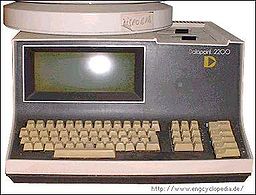- Datapoint 2200
-

Datapoint 2200 computerManufacturer Computer Terminal Corporation Release date June 1970 Discontinued 1979[1] Operating system Datapoint O/S CPU 8-bit, made from standard TTL components. The Intel 8008 was a nearly 100% compatible LSI implementation. Memory 2 KB standard; expandable to 16 KB Display Text only, 80×12 characters The Datapoint 2200 was a mass-produced programmable terminal, designed by Phil Ray and Gus Roche,[2] announced by Computer Terminal Corporation (CTC) in June, 1970 (with units shipping in 1971). It was intended by its designers simply to be a versatile, cost-efficient terminal for connecting to a wide variety of mainframes by loading various terminal emulations from tape rather than being hardwired as most terminals were. However, enterprising users in the business sector (including Pillsbury Foods) realized that this so-called "programmable terminal" was equipped to perform any task a simple computer could, and exploited this fact by using their 2200s as standalone computer systems. Equally significant is the fact that the terminal's multi-chip CPU (processor) became the embryo of the x86 architecture which the original IBM PC and its descendants are based on.
Contents
Technical description
The Datapoint 2200 had a built-in full-travel keyboard, a built-in 12-line, 80-column green screen monitor, and two cassette tape drives each with 130 KB capacity. Its size (approx. 2w×2d×1h ft) and shape (a box with protruding keyboard) approximated that of an IBM Selectric typewriter. Initially a Diablo 2.5 MB 2315-type removable cartridge hard disk drive was available, along with modems, several types of serial interface, parallel interface, printers and a punched card reader. Later, an 8-inch floppy disk drive was also made available, along with other, larger hard disk drives. An industry-compatible 7/9-track (user selectable) magnetic tape drive was available by 1975. In late 1977, Datapoint introduced ARCnet local area networking. The original Type 1 2200 shipped with 2 kilobytes of serial shift register main memory, expandable to 8K. The Type 2 2200 used denser 1 kbit RAM chips, giving it a default 4K of memory, expandable to 16K. Its starting price was around US$5,000, and a full 16K Type 2 2200 had a list price of just over $14,000. The 2200 models were succeeded by the 5500, 1100, 6600, 3800, 8800, etc.
The seed of the x86 architecture
Aside from being one of the first personal computers, the Datapoint 2200 has another connection to computer history. Its original design called for a single-chip 8-bit microprocessor for the CPU, rather than a conventional processor built from discrete TTL modules. In 1969, CTC contracted two companies, Intel and Texas Instruments, to make the chip. TI was unable to make a reliable part and dropped out. Intel was unable to make CTC's deadline. Intel and CTC renegotiated their contract, ending up with CTC keeping its money and Intel keeping the eventually completed processor.[2]
CTC released the Datapoint 2200 using about 100 discrete TTL components (SSI/MSI chips) instead of a microprocessor, while Intel's single-chip design, eventually designated the Intel 8008, was finally released in April 1972.[3] The 8008's seminal importance lies in its becoming the ancestor of Intel's other 8-bit CPUs, which were followed by their assembly language compatible 16-bit CPU's—the first members of the x86-family, as the instruction set was later to be known. Thus, CTC's engineers may be said to have fathered the world's most commonly used and emulated instruction set architecture from the mid-1980s to date[update].
Credits
The original instruction set architecture was developed by Victor Poor and Harry Pyle. The TTL design they ended up using was made by Gary Asbell. Industrial design (how the box's exterior looked, including the company's logo) was done by Jack Frassanito.
Specifications
Main unit
- CPU: 8-bit, made from standard TTL components. The Intel 8008 was a nearly 100% compatible LSI implementation.
- RAM: 2K, expandable to 16K
- Display: Text only, 80×12 characters
- Storage: 2 tape drives, optional 8-inch Shugart floppy drive
Peripherals
Users of the 2200 and succeeding terminals eventually had several optional units to choose from. Among these were
References
- ^ OLD-COMPUTERS.COM : The Museum
- ^ a b Lamont Wood, "Forgotten PC history: The true origins of the personal computer", Computerworld, 8 August 2008
- ^ Thompson Kaye, Glynnis (1984). A Revolution in Progress - A History to Date of Intel. Intel Corporation. pp. 13. Order number:231295. http://www.intel.com/museum/archives/brochures/brochures.htm. "The 8-bit 8008 microprocessor had been developed in tandem with the 4004 and was introduced in April 1972. It was originally intended to be a custom chip for Computer Terminals Corp. of Texas, later to be known as Datapoint." "As it developed, CTC rejected the 8008 because it was too slow for the company's purpose and required too many supporting chips."
External links
- Information about the Datapoint 2200 at OLD-COMPUTERS.COM – Including a picture of the terminal
- Datapoint documentation on bitsavers.org
- Page with links to a doctoral thesis about early microprocessor history, with lots of details about Datapoint's role, and a copy of the Datapoint 2200 Programmer's Guide (both in PDF format) – both with a lot of historical detail.
- The man who invented the PC
- Unofficial Datapoint Organization WEB site at datapoint.org
Categories:- Character-oriented terminal
- Early microcomputers
- Personal computers
- 1970 introductions
Wikimedia Foundation. 2010.
